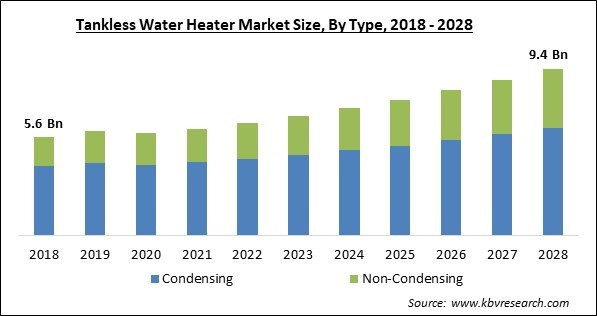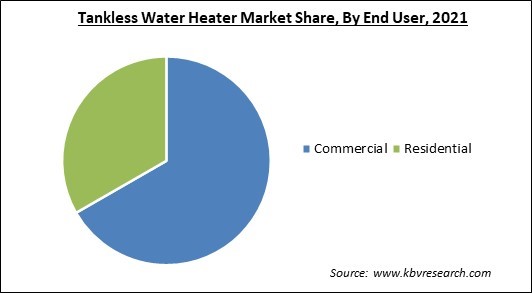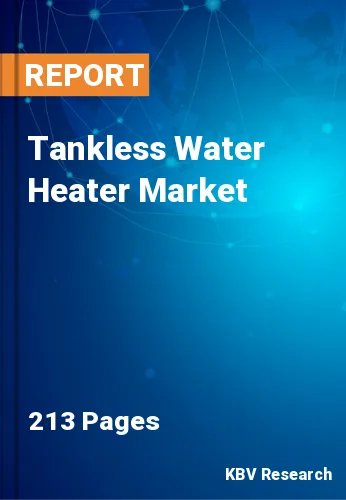The Global Tankless Water Heater Market size is expected to reach $9.4 billion by 2028, rising at a market growth of 6.7% CAGR during the forecast period.
A tankless water heater is a type of heater that heats water using either gas or electricity as an energy source. It differs from conventional or tanked water heaters in that it heats water as it goes through the heating units quickly rather than storing it. The main factors boosting the growth of the tankless water heater market are an increase in infrastructure improvements, the replacement of conventional and tank-based water heaters along with modern tankless water heaters, as well as the deployment of smart water heaters. In addition, a greater emphasis on producing tankless electric water heaters with improved quality, safety awareness, and energy efficiency is anticipated to open up significant growth opportunities for major players in this market.

Tankless water heater use is anticipated to rise in the coming years as businesses introduce more advanced tankless water heaters. For instance, one of the top producers of commercial tankless water heaters and a leader in clean technology IoT, Intellihot Inc., introduced the Neuron Series of water heaters. These models have cellular Wi-Fi connectivity enabling remote flow and water temperature monitoring. These models also fit in existing water connections and are made for use in schools, restaurants, and hotels, which eliminates the need for re-piping and reduces installation time by half. The majority of the businesses that produce these kinds of heaters also offer extra features in some of their models.
Due to their ability to save space and energy, these heaters are likely to be adopted by residential as well as commercial sectors at a rapid rate throughout the coming years. Additionally, many tankless water heaters have energy star ratings, which make them cost-effective and environmentally good for consumers. Additionally, these devices typically cost more than a normal 40-gallon water heater, but they typically have longer warranty periods and last longer than the latter. Additionally, a tankless water heater can reduce the annual electric expenditure significantly. The storage tank is the most often used type of water heating technology in the residential market.
The COVID-19 pandemic had a detrimental impact on a number of businesses and nations. Due to the worldwide lockdown, a decline in the growth rate of the construction and building, transportation, automotive, oil and gas, and energy sectors has been observed. As a result, there is now less demand for tankless water heaters, which hindered the market's expansion in 2020. In order to stop the spread of the coronavirus, countries with developed economies imposed robust measures, such as achieving social seclusion and limiting mobility and transportation.
In the era of modern and advanced technologies, people are continuously adopting the latest innovations across their homes as well as workplaces. The tankless water heater is a novel technology that is far better than traditional water heating equipment, due to which, it is widely being employed in commercial as well as residential applications. Tankless water heaters are being used to replace conventional water heaters as a result of various government rebates and subsidies as well as consumers' changing attitudes regarding advanced heaters

One of the main factors driving the market expansion for tankless water heaters is the increase in construction activities all over the world along with the rising government expenditure in the construction sector. With the rapid diffusion of urbanization across people all over the world, the demand for more residencies is booming. In addition, a significant number of people are now shifting to urban areas. To fulfill their requirement, various governments are increasing their efforts in the construction sector. Due to all these aspects, the construction sector across the world is rapidly expanding. With the increasing growth of the construction industry, the demand for tankless water heaters is also expediting.
Maintenance is necessary for tankless water heaters at least once each year. Minerals accumulate inside the water heater over time, necessitating a system flush to avoid damage or a reduction in performance. Moreover, the user needs to flush the heater at least two times a year if it is deployed in an area with a hard water supply. Since the majority of warranties do not cover the damage from mineral build-up, this maintenance schedule is crucial to keep the device in a good condition. leaning the air filter as well as the water filter are examples of routine maintenance and care. Since they differ by model, it should also be considered that how frequently these heaters are needed to be cleaned.
Based on type, the tankless water heater market is segmented into Condensing and Non-Condensing. In 2021, the condensing segment acquired the largest revenue share of the tankless water heater market. This growth is attributed to the increase in the demand for condensing heaters across a variety of applications, including hotels, buildings, and other infrastructures. Condensing tankless water heaters use a variety of techniques to extract more heat from the exhaust gases, resulting in cooler exhaust gases that are typically around 100° F.
On the basis of energy source, the tankless water heater market is divided into Electric and Gas. In 2021, the gas segment recorded a substantial revenue share of the tankless water heater market. The constantly rising growth of the segment is attributed to the low investment cost for deploying this type of water heaters. Gas-operated water heaters are less expensive in contrast to electric water coolers. In addition, the maintenance cost of these water heaters is also lower. Gas tankless water heaters are very popular among small organizations.
By energy factor, the tankless water heater market is classified into 0.80 to 0.90 EF and 0.91 to 0.99 EF. The 0.91 to 0.99 EF segment witnessed the biggest revenue share of the tankless water heater market. This is due to an increase in research and development efforts for the creation of extremely efficient tankless water heaters. In addition, rising prices of electricity all over the world are also playing a major role in accelerating the growth of this segment.
Based on end-user, the tankless water heater market is fragmented into Residential and Commercial. In 2018, the residential segment held a substantial revenue share of the tankless water heater market. The key driver boosting demand for these items in the residential market is the rising use of environmentally friendly and energy-efficient products, such as tankless water heaters. The growth of the disposable income of people all over the world, especially in developed economies, is also anticipated to increase the number of residential units, which is estimated to encourage the use of these solutions throughout the forecast period.
| Report Attribute | Details |
|---|---|
| Market size value in 2021 | USD 6 Billion |
| Market size forecast in 2028 | USD 9.4 Billion |
| Base Year | 2021 |
| Historical Period | 2018 to 2020 |
| Forecast Period | 2022 to 2028 |
| Revenue Growth Rate | CAGR of 6.7% from 2022 to 2028 |
| Number of Pages | 213 |
| Number of Tables | 402 |
| Report coverage | Market Trends, Revenue Estimation and Forecast, Segmentation Analysis, Regional and Country Breakdown, Companies Strategic Developments, Company Profiling |
| Segments covered | Type, Energy Source, Energy Factor, End User, Region |
| Country scope | US, Canada, Mexico, Germany, UK, France, Russia, Spain, Italy, China, Japan, India, South Korea, Singapore, Malaysia, Brazil, Argentina, UAE, Saudi Arabia, South Africa, Nigeria |
| Growth Drivers |
|
| Restraints |
|
Region-wise, the tankless water heater market is analyzed across North America, Europe, Asia Pacific and LAMEA. Europe accounted for the largest revenue share of the tankless water heater market in 2021. The expansion of tankless water heaters in this region is related to an increase in investments in low-carbon energy generation and a surge in the demand for replacing old conventional water heaters. Moreover, there is a significant prevalence of major market players operating in the field of tankless water heaters in the region. This factor would bolster the growth of the regional tankless water heater market.
Free Valuable Insights: Global Tankless Water Heater Market size to reach USD 9.4 Billion by 2028
The market research report covers the analysis of key stake holders of the market. Key companies profiled in the report include A. O. Smith Corporation, Robert Bosch GmbH, Stiebel Eltron GmbH & Co. KG, Takagi Seiko Co., Ltd., Kyungdong Navien Co., Ltd., Noritz Corporation, Bradford White Corporation, EcoSmart Green Energy Products, Inc., Rinnai Corporation, and Rheem Manufacturing Company.
By Type
By Energy Source
By Energy Factor
By End User
By Geography
The global Tankless Water Heater Market size is expected to reach $9.4 billion by 2028.
Replacement Of Traditional Water Heaters With Tankless Water Heaters are driving the market in coming years, however, Requirement For Frequent Maintenance restraints the growth of the market.
A. O. Smith Corporation, Robert Bosch GmbH, Stiebel Eltron GmbH & Co. KG, Takagi Seiko Co., Ltd., Kyungdong Navien Co., Ltd., Noritz Corporation, Bradford White Corporation, EcoSmart Green Energy Products, Inc., Rinnai Corporation, and Rheem Manufacturing Company.
The expected CAGR of the Tankless Water Heater Market is 6.7% from 2022 to 2028.
The Electric segment acquired maximum revenue share in the Global Tankless Water Heater Market by Energy Source 2021 thereby, achieving a market value of $6.9 billion by 2028.
The Europe market dominated the Global Tankless Water Heater Market by Region 2021, and would continue to be a dominant market till 2028; thereby, achieving a market value of $3,246.7 million by 2028.
Our team of dedicated experts can provide you with attractive expansion opportunities for your business.

